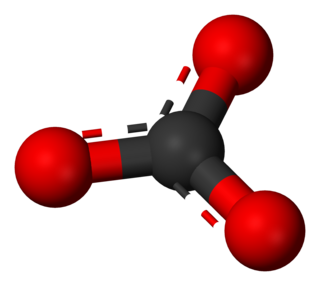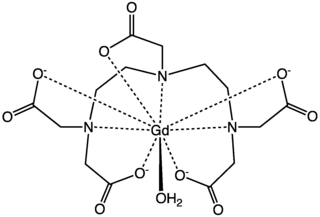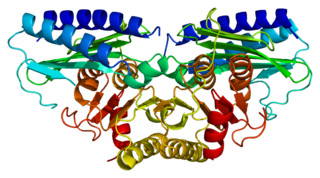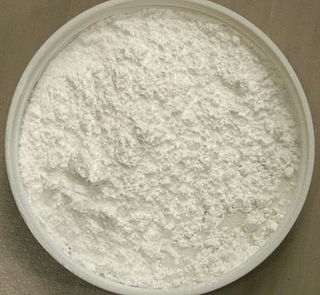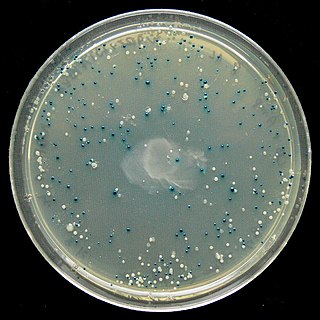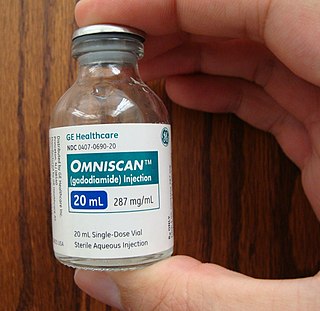Molecular imaging is broadly defined as the visualization of molecular and cellular processes on either a macro- or microscopic level. Because of its high spatial resolution and ability to noninvasively visualize internal organs, magnetic resonance (MR) imaging is widely believed to be an ideal platform for in vivo molecular imaging. [1] For this reason, MR contrast agents that can detect molecular events are an active field of research. [2] One group of compounds that has shown particular promise is enzyme-activated MR contrast agents.

Molecular imaging originated from the field of radiopharmacology due to the need to better understand fundamental molecular pathways inside organisms in a noninvasive manner.

Magnetic resonance imaging (MRI) is a medical imaging technique used in radiology to form pictures of the anatomy and the physiological processes of the body. MRI scanners use strong magnetic fields, magnetic field gradients, and radio waves to generate images of the organs in the body. MRI does not involve X-rays or the use of ionizing radiation, which distinguishes it from CT or CAT scans and PET scans. Magnetic resonance imaging is a medical application of nuclear magnetic resonance (NMR). NMR can also be used for imaging in other NMR applications such as NMR spectroscopy.
Contents
- Structure of β-galactosidase-activated contrast agents
- Mechanism of activation
- Uses
- Basic research
- Clinical medicine
- Limitations
- References
Enzyme-activated MR contrast agents are compounds that cause a detectable change in image intensity when in the presence of the active form of a certain enzyme. This makes them useful for in vivo assays of enzyme activity. They are distinguished from current, clinical MR contrast agents that give only anatomical information, [3] such as aqueous gadolinium compounds, by their ability to make molecular processes visible. Enzyme-activated contrast agents are powerful tools for molecular imaging. To date, β-galactosidase-activated contrast agents have attracted the most attention in the literature, although there no theoretical reason that other enzymes could not be used to activate contrast agents. Also, mechanisms other than enzyme activation, such as Ca2+-dependent activation, can theoretically be used. [2]

Enzymes are macromolecular biological catalysts that accelerate chemical reactions. The molecules upon which enzymes may act are called substrates, and the enzyme converts the substrates into different molecules known as products. Almost all metabolic processes in the cell need enzyme catalysis in order to occur at rates fast enough to sustain life. Metabolic pathways depend upon enzymes to catalyze individual steps. The study of enzymes is called enzymology and a new field of pseudoenzyme analysis has recently grown up, recognising that during evolution, some enzymes have lost the ability to carry out biological catalysis, which is often reflected in their amino acid sequences and unusual 'pseudocatalytic' properties.

Gadolinium is a chemical element with the symbol Gd and atomic number 64. Gadolinium is a silvery-white metal when oxidation is removed. It is only slightly malleable and is a ductile rare-earth element. Gadolinium reacts with atmospheric oxygen or moisture slowly to form a black coating. Gadolinium below its Curie point of 20 °C (68 °F) is ferromagnetic, with an attraction to a magnetic field higher than that of nickel. Above this temperature it is the most paramagnetic element. It is found in nature only in an oxidized form. When separated, it usually has impurities of the other rare-earths because of their similar chemical properties.
In general, enzyme-activated agents contain a paramagnetic metal ion which can affect the T1 or T2 relaxation times for nearby water molecules. However, the metal ions are unable to interact with the water until an enzyme-catalyzed reaction takes place. Steric hindrance or coordination with other ions prevents water from accessing the paramagnetic center prior to the enzymatic reaction. [4]

